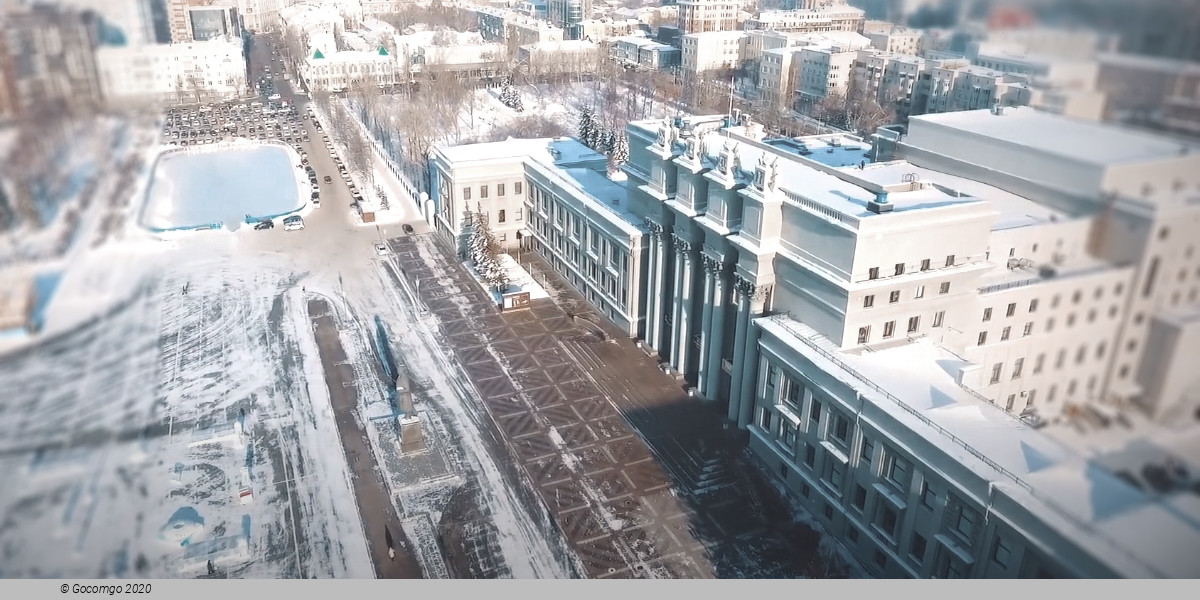Samara

Samara in Russia and the administrative center of Samara Oblast. Some statistics indicate that it is the eighth or ninth-largest city by population, rather than sixth. It is in the southeastern part of Western Russia at the confluence of the Volga and Samara rivers, on the east bank of the Volga which acts as the city's western boundary; across the river are the Zhiguli Mountains, after which the local beer (Zhigulyovskoye) is named. The northern boundary is formed by the Sokolyi Hills and by the steppes in the south and east. The city covers 46,597 hectares (115,140 acres), with a population of 1,164,685 (2010 Census); the metropolitan area of Samara, Tolyatti, and Syzran has a population of over 3 million. It is about 300 kilometres (190 mi) from Kazan, 410 kilometres (250 mi) from Ufa, 340 kilometres (210 mi) from Saratov, and 235 kilometres (146 mi) from Oral, Kazakhstan.
Samara has an opera and ballet theater, a philharmonic orchestra hall, and five drama theaters. There is a museum of natural history and local history studies, a city art museum, and a number of movie theaters. As a dedication to the city's contribution to the development of aerospace industry there is a museum Cosmic Samara and an exhibition of aerospace history in Samara State Aerospace University. In the 2000s there has also occurred a large number of art galleries, dedicated to contemporary art.
There is a zoo and a circus in the city.
Samara Regional Museum of Local History named after Pyotr Vladimirovich Alabin is one of the oldest museums of the Volga region, founded on November 13, 1886. At present museum offers 2,500 square meters of exposition and exhibition areas, a 270-seat cinema/lecture hall, and a library with a reading hall. Museum's funds contain around 230,000 items, including abundant archaeological and scientific collections (paleontological, mineralogical, zoological, botanical), and impressive folklore and ethnographical collections. Visitors are offered a wide choice of interesting expositions: paleoecological – "Natural communities of Samara region", archaeological – "Priceless heritage of the times gone by", ethnographic – "Circle of life, reflected in traditions and rituals of the Volga region indigenous peoples", historical – "The Crossroads of Samara history", and other exhibition projects.
The Alabin Museum has three branches:
House-Museum of Vladimir Lenin in Samara is an object of cultural heritage of federal significance. Museum is located on the site of a former city merchant's mansion, dating to the last quarter of the 19th century. The Ulyanov family rented a second floor apartment of the house of Samara merchant Ilya Rytikov from May 1890 to August 1893. During this time Vladimir Ulyanov graduated from St. Petersburg University law school as a non-resident student, and started employment at Samara Regional Court. House-Museum of Vladimir Lenin in Samara opened on January 3, 1940. At present the museum's second floor houses a permanent memorial/household exhibition "Ulyanov family’s apartment in Samara, 1890–1893", recreating the living conditions and household atmosphere of Ulyanov family. The ground floor contains a specialised display area, including a fragment of historical/artistic reconstruction of Ilya Rytikov's merchant shop.
Exposition of Russia's first Museum of Art Nouveau is dedicated to art and culture of late 19th – early 20th centuries. Museum of Art Nouveau opened at the end of 2012 and in just a few years became a local tourist brand. Mansion of Alexandra Kurlina, a merchant's wife and philanthropist, where the museum is located, is considered to be an architectural gem of Samara's Art Nouveau. Original façade and interior survive to this day, representing the works of outstanding European and Russian art nouveau masters. The museum is an exhibition space, which hosts major Russian museums’ projects (The Pushkin Museum, Abramtsevo Museum-Reserve, Moscow Multimedia Art Museum, etc.), and organises exhibitions of its own collections. Museum of Art Nouveau is one of Samara's most popular social and cultural entities. Weekly events take place here, giving visitors a taste of late 19th – early 20th centuries’ culture, as well as current cultural trends. Every year the museum hosts the "Night at the Museum" and "Night of the Arts" events, attended by more than a thousand visitors.
House-Museum of Mikhail Frunze in Samara opened on February 23, 1934. The building was constructed in 1891 and is classed as a monument of residential architecture. On February 23, 2004, on the eve of the 70th anniversary of the museum, a new, 3rd exposition was opened, in which new materials, previously classified as top secret, were exhibited. The exposition tells visitors about lesser known chapters of the 1918-1920 Civil War, the confrontation on the Eastern Front between the armies of Mikhail Frunze and Alexander Kolchak, about "The Reds", "The Whites" and "The Greens", about anti-Soviet uprising behind the lines of the Eastern Front – "Chapan war" ("chapan" means rustic sheepskin coat), the defection in the Red and White armies, and many other chapters of the Russian history.

